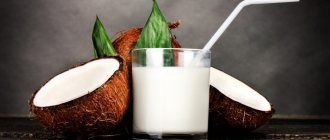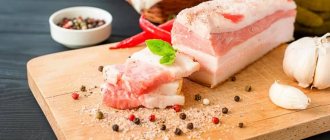Hello, dear readers, today we will again talk about tasty and healthy things. There are many interesting fruits in the world. And in previous materials we talked to you about pineapple and avocado. Now, I think you will also be interested in the topic: What are the benefits of coconut? So, what is the benefit of coconut, its composition, how to properly cut this fruit, what is coconut milk and oil? We will talk about this much more in this article.
What do coconuts look like and where do they grow?
Coconut is a round, slightly elongated fruit of the coconut palm. Its length reaches 25 - 30 cm, and its weight is 2.5 kg. People tend to think of coconut as a nut, which is considered a mistake. This is a drupe, the inner part of which is called the endocarp, and the outer part is called the exocarp. The pulp located inside is 12 mm thick and contains liquid containing nutrients, starch and proteins. This water is called edosperm. As soon as the exotic begins to ripen, it is transparent and a little cloudy. In ripe fruit, the water acquires a yellowish tint and is saturated with oils. Mixing with the pulp, the water turns into coconut milk, which has a sweetish taste.
The best soil for coconut palm growth is sandy soil. The wild variety prefers the tropics. Palm trees grow in large numbers along the coastal strip of the Malay Peninsula, Sri Lanka. The habitats of these trees include the Indian coasts and the Philippines. And in Indonesia, the processing and production of coconuts is the most developed, in which it ranks first.
What kind of fruit, where does it come from?
Don't call coconuts fruits. They are not nuts either, although that is often what they are called. These are drupes, the seeds of coconut palms, the only representatives of the genus Cocos in the palm family. Among the drupes we know: walnut, almond, apricot, plum, cherry.
Coconut palms grow wild and cultivated in almost all tropical countries and thrive on sea coasts - they do not care for salt water. Cultivated palms begin to bear fruit at the age of 7-9 years and bear fruit for almost half a century, annually producing from several tens to two hundred fruits.
Coconuts grow in groups and mature in approximately 8-9 months, and the fruit can weigh up to 2.5 kg. They are waterproof, therefore, even if they fall into the sea and make a long swim on the waves to other shores, they retain the ability to germinate and give life to a new palm tree.
They are grown in Indonesia, the Philippines, India, Papua New Guinea, Malaysia and a dozen other countries, and whether coconut is healthy is known in all parts of the world.
What types of coconuts are there?
A coconut remains the same, no matter how it looks. Known types of coconuts are round, oval or elongated. Their colors range in different shades, from yellow and orange to green and brown. There is also variety in size - there are modest coconuts and real giants.
But the heroic size of the fruit does not guarantee that the product has much more pulp and juice than its modest-sized brother.
People began to practice using coconut for their needs a long time ago; it has entered many areas of life, including outside the countries where it grows.
The consumer properties of different parts of coconut depend on the degree of maturity, and taking this into account, they are widely used in medicine, cosmetology, cooking, furniture production, the construction industry, gardening, for making souvenirs, and for household needs.
Vitamins and minerals in coconut
The benefits and harms of coconut for the human body are being studied by scientists. They claim that the composition of its water resembles the composition of blood. Edosperm contains an amount of useful elements equal to those required by the body. Thanks to its rich composition, drupes can be used in many ways. It contains:
- amino acids;
- antioxidants;
- healthy fiber;
- essential oils.
Exot boasts a rich vitamin composition.
Per 100 g of product there are:
| Vitamin | Amount, mg |
| IN 1 | 0,066 |
| AT 2 | 0,02 |
| AT 3 | 0,3 |
| AT 6 | 0,054 |
| AT 9 | 26 |
| WITH | 3,3 |
| E | 0,24 |
| TO | 0,2 |
| RR | 0,54 |
| Kholin | 12,1 |
The benefits of coconut for the body are enhanced by its rich mineral composition:
| Name | Amount, mg per 100 g |
| Potassium | 356 |
| Calcium | 14 |
| Magnesium | 32 |
| Sodium | 20 |
| Manganese | 1,5 |
| Copper | 0,4 |
| Selenium | 0,022 |
| Phosphorus | 113 |
| Iron | 2,43 |
| Zinc | 1,1 |
Due to the rich mineral content of drupe water, it has beneficial properties for active people and athletes, replacing sports drinks.
How many calories are in coconut
Coconut is a unique product. This is high-calorie pulp and water, which contains virtually no calories.
Calorie content and nutritional value (BJU):
| Name | In water, g | In pulp, g |
| Squirrels | 4 | 3,33 |
| Fats | 27 | 33,49 |
| Carbohydrates | 6 | 15,23 |
| Calories | 360 | 16,7 |
The calorie content of a dry tropical delicacy is even higher than that of pulp.
It is 590 kcal per 100 g of product.
Useful properties of coconut
The health benefits and harms of coconut directly depend on the content of vitamins, minerals and nutrients in it. They are the main substances that are required for the proper functioning of internal organs. For athletes, especially weightlifters, the benefits of coconut pulp are valuable. It is rich in proteins, the properties of which help you gain muscle mass faster, and a large amount of calories saturates the body with energy. Coconut is an excellent remedy for people who want to gain the missing weight without harm to their health.
The benefits of coconut pulp are that it:
- strengthens the immune system;
- improves eye health and improves vision;
- normalizes heart function and cardiovascular system functions;
- is a preventative against the harm of malignant neoplasms.
The beneficial properties of coconut pulp do not end there. Like the liquid, it is an anti-inflammatory and antibacterial agent. In general, coconut can be classified as a natural antioxidant.
Milk has diuretic properties. It helps improve the functioning of the kidneys and central nervous system. It is recommended to drink milk to strengthen your teeth and prevent diseases. The liquid contains cytakins, which prevent the harmful formation of cancer cells. Due to the healing properties of milk:
- has a rejuvenating effect;
- is a prophylactic agent for thrombosis;
- improves metabolism and digestion process;
- strengthens the immune system;
- reduces cholesterol and blood sugar;
- normalizes blood pressure;
- prevents the development of atherosclerosis;
- Helps cure sore throat and other colds.
We recommend reading: What are the benefits of rye flour?
The benefits of young coconut largely lie in its water. It is found only in unripe nuts and is very different from milk in its sweet-sour taste and calorie content. This is an excellent thirst quencher that has beneficial properties that restore water balance in the human body. Among its beneficial properties is the ability to eliminate infections in the bladder. The composition of drupe water can be compared to saline solution.
The benefits of coconut water for delicate skin are great. It helps relieve lethargy, tones the skin, and stops age-related changes. In adolescence, it is used to eliminate acne.
Benefits of coconut for women
The benefits of coconut for a woman’s body are unconditional. Its beneficial substances help strengthen hair. Coconut enriches hair with nutrients and restores it after damage. The beneficial properties of essential oils, milk, water and pulp are used in cosmetology. They are added to masks with anti-aging properties, creams for dry skin, shampoos and rinses. Facial products smooth out and prevent the appearance of age-related wrinkles and tone the skin.
Without any harm, the health benefits of coconut for older women are significant. Its use in food helps improve the functioning of the urinary and reproductive systems, and also delays the onset of menopause.
Benefits of coconut for men
The benefit of coconut for a man’s body is that it is a strong aphrodisiac and strengthens the reproductive system. Exot serves as a prophylactic for prostatitis and diseases of the urinary system. Despite the fact that coconut has health benefits for men, in some cases it can also cause harm. Basically, this occurs with individual intolerance to the product and with obesity.
Coconut water
The water inside a fresh coconut is completely sterile. Its composition is close to human blood plasma. Previously, in critical situations, coconut water was used for transfusions. Today it is used as a refreshing drink, which not only quenches thirst and invigorates, but also improves immunity and replenishes electrolytes.
Fresh coconut juice contains the hormone phytokinin, which can rejuvenate. The exotic fruit is extremely useful for girls and women. Its water can be used as a facial toner. It actively fights acne and prevents its occurrence.
The following properties of coconut are beneficial for the body:
- Thanks to the potassium, magnesium and vitamin C it contains, it stabilizes blood pressure. Drinking two cups of coconut water a day is enough to prevent the unpleasant symptoms of hypertension.
- Reduces bad cholesterol levels. Reduces the likelihood of blood clots and improves blood circulation. As a result, the risk of strokes and heart attacks is reduced.
- Helps restore the body after poisoning and during a hangover.
- Reduces the frequency of migraines in people suffering from magnesium deficiency.
- Is a natural diuretic.
- Helps cleanse the blood. It is enough to drink 100 ml of juice on an empty stomach immediately after sleep.
- It has a low glycemic index, which means it is suitable for diabetics.
At what age can children eat coconut?
The benefits of fresh coconut are also significant for children. The beneficial calcium it contains plays an important role in the development of the child's teeth and bones. The tropical nut promotes the normal growth and development of the baby, saturates it with energy and nutrients. Drupe oil is a mild, natural remedy that can be used to care for delicate baby skin. But when introducing the product into a child’s diet, it should be taken into account that the child’s stomach is very susceptible. Therefore, it is necessary to give exotic to children from 1.5 to 2 years of age. If a child has an allergic reaction to any food, it is better to delay or minimize the consumption of the fruit. It is recommended to introduce exotic fruits into children’s diets from the age of 3, after checking for the absence of allergic reactions.
The benefits and harms of coconut for weight loss
The benefits of coconut for weight loss are enhanced by lauric acid, which is the main component that helps in the fight against excess weight. Among the properties of dodecanoic acid are:
- the ability to burn excess fat;
- improvement of digestive system processes;
- acceleration of metabolism;
- decreased feeling of hunger.
Due to its high calorie content, exotic fruit tends to quickly saturate the body, but thanks to the fiber, it does not gain excess weight. Vegetable fats are converted into energy and are not stored in fat folds.
Despite the benefits of coconut, harm from its use is possible if you have health problems. Its excessive consumption can lead to high cholesterol, disrupt heart function and cause pathologies. You should discard the product if your body is intolerant of its components or if you are obese.
Benefits for women
Young coconut has great benefits for the female body:
- It has a pronounced cosmetic effect, improves the condition of the skin and hair.
- Helps regulate the menstrual cycle. Reduces pain during menstruation, prevents the development of fungal infections.
- Protects women from breast cancer.
- Perfectly heals postpartum injuries. Prevents the appearance of stretch marks. Lightens age spots.
During lactation, women can drink a few tablespoons of coconut oil, which will increase the nutritional value of breast milk. The rich vitamin and mineral composition will make breastfeeding more complete.
Features of eating coconut for diabetes and gastritis
Diabetics should consume coconut with caution. You can introduce pulp into your diet in small quantities. The benefit of coconut for the body is also that the manganese it contains reduces blood sugar. For diabetes, you can use exotic water, which tends to relieve fever. But you should avoid sugar, butter and drupe milk. These parts of the tropical fruit are incompatible with diabetes.
For stomach diseases, including gastritis and ulcers, it is recommended to consume milk and dairy products. For people who are intolerant to this type of food, coconut milk is an excellent replacement option. It contains coarse fibers that have a positive effect on the digestive system and improve metabolic processes. Another useful property of tropical milk is its ability to normalize the intestinal microflora without harm to the gastrointestinal tract.
We recommend reading: Humic acids: effects on the human body, properties and applications
The exotic fruit has antibacterial properties, so it is recommended for use by anyone who has gastritis. But for ulcers, it is necessary to administer a moderate amount of the product so as not to overload the stomach.
Coconut oil
Coconut oil can be easily found on sale. For its production, the cold pressing method is used. The preparation technology allows us to obtain two types of oils: unrefined and transparent refined product.
When answering the question about the benefits and harms of coconut, you need to remember that the fatty acids in its oil do not affect the growth of cholesterol and the increase in adipose tissue, but promote rapid weight loss. Thanks to research, it was possible to reveal that daily consumption of 2 tbsp. l. fresh coconut oil for two months significantly reduces the amount of fat in the abdominal cavity.
The fats contained in coconut have a beneficial effect on the human brain. Research results published in Neurobiology of Aging proved the following. Treatment of patients with Alzheimer's disease with the use of medium chain triglycerides (the source of which is coconut) leads to an increase in the concentration of ketone bodies, and at the same time to a decrease in dysfunction.
It is better to use oil for medicinal purposes under the guidance of a doctor. The study of the chemical composition of coconut and its benefits for the human body made it possible to use coconut oil for the following purposes:
- Treatment of infections caused by herpes, influenza and measles viruses.
- Prevention of osteoporosis (decreased bone density).
- Treatment of skin diseases.
- Prevention of gastrointestinal, kidney and liver diseases.
- For fast weight loss.
Applications of coconut
Coconut is a unique product with a variety of unique properties that are used in various fields. Its fibers are used to make twines, ropes, and carpets.
The product is added to the substrate for flowers and plants intended for home cultivation.
Souvenir decorations and dishes are made from the shell. This is an excellent material for making charcoal.
Coconut oil is considered one of the most valuable for cosmetic use: it is widely used to add to masks, face and body creams, shampoos and other hair products. In its pure form, it is used in massage parlors, including to combat cellulite.
In the culinary field, desserts are prepared from tropical delicacies. The components of the drupe are added to baked goods. And from coconut shavings, pastry chefs create interesting decorations for cakes, buns and other delicious products.
What are the benefits of coconut for the body?
The healing properties of the coconut fruit are a real salvation for people suffering from the following ailments:
- inflammatory processes, infections, viruses, bacteria - properties appear due to the lauric acid present in the composition, which is also found in the breast milk of a nursing mother;
- has a beneficial effect on the nervous system because it contains large amounts of magnesium, boron and bromine. Also responsible for the absence of depression, because it promotes the production of serotonin and endorphin;
- problems with the cardiovascular system;
- helminthiasis, especially in milk;
- has a positive effect on the course and prevents the development of Alzheimer's disease;
- normalizes hormonal balance, prevents enlargement of the thyroid gland;
- promotes normal digestion, for example, heals ulcers, eliminates constipation;
- an effective remedy to combat atherosclerosis;
- reliable protection and prevention of cancer;
- has a beneficial effect on joints.
Video: beneficial properties of coconut
Important! Thanks to its bactericidal properties
coconut does not rot, it is not afraid of moisture, it can remain firm and elastic for several years if it does not have any deformations.
Women
Coconut effectively protects the female body from the occurrence of cancerous tumors, in particular breast cancer. It is often used in the beauty industry because it has a positive effect on the condition of the skin of the face and body.
Coconut oil eliminates the problems of oily skin: it is recommended to apply it to problem areas, and it dries and normalizes the secretion of subcutaneous sebum. The oil is often used as a remedy to help get rid of wrinkles, and in adolescence it is a fairly effective way to get rid of acne.
It also has a good effect on the condition of the hair, improving its structure and appearance due to the fact that it provides the necessary nutrition. Coconut milk helps eliminate varicose veins. In cosmetology it is used as a makeup remover and skin care product, and also as a hygienic lipstick.
Recommended for use by pregnant women to lighten age spots that appear during pregnancy and prevent stretch marks. Has a positive effect in the healing of postpartum injuries.
Men
Coconut milk can be used as a shaving cream and then as a sanitizer after this process. Eating coconut is a powerful aphrodisiac that helps men establish or increase their desire for intimacy with women.
Natural aphrodisiacs also include: actinidia, saffron, nut grass, horseradish, strawberry, lychee, arugula, bifolia and walnut.
In case of serious problems with the skin, for example, the appearance of eczema or psoriasis, coconut is an effective remedy. It also has a good effect on joints, keeping them youthful and mobile.
How and with what do you eat coconut?
Thanks to its healing properties, taste and minimal potential for harm to health, the tropical delicacy occupies a significant place in cooking. Adding its healthy pulp adds an exotic touch to appetizers, salads, and main courses. Fetal milk is used to prepare desserts, drinks, and soups. Coconut is combined with poultry meat, especially chicken and rabbit. It is added to porridge. Seafood, potatoes and peppers go well with tropical fruits. It is compatible with other exotic fruits, citruses and strawberries. The combination of coconut and spices is interesting. And the combination with chocolate and caramel is used to prepare confectionery products.
Easy to include in your diet
Coconut flakes add a nice flavor to savory dishes. Coconut's meaty texture and flavor pair well with curries, fish stews, rice dishes, or even breaded shrimp.
Keep in mind that some brands contain added sugar, which may not be suitable for salty dishes. Be sure to check the ingredients label.
Shredded coconut is great for baking and adds a hint of natural sweetness and moisture to cookies and muffins.
Topping your oatmeal with raw coconut adds texture and tropical flavor. Added to pudding or yogurt, it is also a tasty calorie booster for those looking to gain weight.
Coconut flour is used in baking instead of wheat flour. It's gluten-free, nut-free, and a popular option for anyone counting carbs.
Because the flour is grain-free, it is also suitable for those following a paleo diet, which does not allow grain products such as regular wheat flour.
However, coconut flour is best used in tried and tested recipes as it will not work like wheat flour and will absorb more liquid than other flours.
Additionally, coconut oil is a delicious heat-resistant fat that can be used in baking, sautéing, or frying.
Summary:
Coconut is versatile in the kitchen and works well in both sweet and savory dishes. This is a great choice for those following a low-carb, paleo, gluten-free, or nut-free diet.
How to break a coconut at home
When starting to open an exotic, you need to prepare two knives: a small one and a large one with a wide blade.
Open as follows:
- Select the most pronounced point.
- Pry it open with a small knife.
- Pour the milk through the hole formed.
- While rotating the coconut, tap it with the flat side of the blade of a large knife for 1 - 2 minutes.
- After a crack appears, continue tapping, turning the fruit around its axis until a crack appears.
When the crack gets bigger, you can try to open the coconut by breaking it.
Video on how to open a coconut
Possible harm of coconut and contraindications
If you don't overuse coconut, you don't have to worry about possible harm from its use. Daily rate of exotic consumption in grams:
| For men | 300 |
| For women | 200 |
| For children from 3 to 10 years old | 50 — 100 |
Excessive consumption can cause hypervitaminosis. And due to the increased calorie content, there is a risk of gaining excess weight. You should avoid introducing the product into your diet if you have a personal intolerance. Diabetics should avoid coconut milk completely.
How to choose the right coconut in the store
When purchasing coconuts, you should ask how long ago they were supplied. Then you need:
- Try the fruit by weight: a high-quality coconut will be heavy if it is small in size.
- Shake the drupe. If you hear gurgling and splashing, it means the nut is ripe. If you don’t hear anything, the liquid may have leaked due to possible damage during transportation or evaporated as a result of long-term storage.
- Examine the coconut for dents, cracks, or other damage that could cause the edible parts of the nut to become unsterile and begin to rot.
- Check whether the coconut points are damaged during transportation.
- A quality nut should be dry.
When buying exotic, do not forget that excellent appearance cannot fully guarantee excellent taste.
How and where to store an open coconut
The product of the tropics is not subject to long-term storage. A whole nut can be kept for no more than a month without losing its beneficial properties. The storage of an open coconut is 2 - 3 days, then it begins to ferment.
Milk should be used immediately after opening. You can store it for only a week by sealing the container with it.
The shelf life of the pulp is 7 days. In this case, it should be filled with water. Dried coconut flakes can be stored for the longest time. It can be kept for about a year by placing it in a cool, dry place, tightly closed.
How to use coconut correctly
- Choosing the right and tasty fruit in a store or market is not always easy. Please note that the coconut water should not make loud “gurgling” sounds when moving the fruit, and the upper shell should not have any damage or cracks.
- To open a coconut, you can use a knife to poke a hole in one of the 3 natural depressions on the surface of the shell. After pouring coconut water into a glass, tapping movements should be made along the diameter of the circumference of the fruit, after which the coconut will easily open.
- The nut pulp does not require special processing and is consumed raw, preferably in the first half of the day.
- It is recommended to store opened coconut for no more than a day to avoid the proliferation of pathogenic microorganisms.










